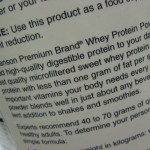Choosing a Quality Whey Protein
 Whey protein supplementation can be a safe and effective way to build lean muscle mass and for weight control. Therefore it is of particular interest to bodybuilders and older individuals looking to boost muscle mass as well as to those concerned with weight-loss. Most readers probably have some familiarity with whey protein either through media, seen it on the shelf or are currently using it. However, fewer may be familiar with the varying qualities of the preparations available to the consumer. In this post, I will discuss what to look for in a whey protein powder.
Whey protein supplementation can be a safe and effective way to build lean muscle mass and for weight control. Therefore it is of particular interest to bodybuilders and older individuals looking to boost muscle mass as well as to those concerned with weight-loss. Most readers probably have some familiarity with whey protein either through media, seen it on the shelf or are currently using it. However, fewer may be familiar with the varying qualities of the preparations available to the consumer. In this post, I will discuss what to look for in a whey protein powder.
What is Whey Protein?
Whey protein is ultimately derived from milk. It is the liquid portion of milk after it coagulates. This liquid which is left over from cheese making is the crudest form of whey protein. One can see this crude form of whey upon opening a container of yogurt; it is the watery fluid floating on the top. In order to get it into the powder form it must go through a refining process. An analogy would be the refining of crude oil into high octane gas to fuel your car. Here crude whey is refined into “high-octane” fuel for muscle growth and repair.
Why That Big-Bucket of Whey from the Big-Box Store May Not be Such a Good Deal
We all know caviar is expensive but tasty. So imagine, if we see a big bucket of it for the same price as a small tin we might be tempted to buy it. However if we look at the label we find that it is the whole sturgeon containing the caviar that has been put through a blender and packaged. I’m sure one taste would tell us this wasn’t a good deal.
While this doesn’t happen in the caviar world; a similar scenario happens in the whey-world.
The problem in the whey-world is that we couldn’t tell the difference between one product to the next by appearance alone. Careful label reading is the only “whey” to tell quality from drool.
The Three Basic Whey Protein Products
The crude liquid whey besides protein contains fats and sugars. Therefore the idea is to process it so that mainly protein remains. All processing should be at low temperatures to keep the proteins from being damaged or “denatured”. The general rule, which holds true for most everything in the real world, the more refined the product the greater is its quality which should result in a premium price.
That said there are three types of whey protein products: concentrate, isolate and hydrolysate. Concentrate is the least processed, isolate is more processed and hydrolysate is the most processed and should fetch the highest price.
Most products on the market contain all three forms of whey in varying amounts. Despite the picture of a hulking-ripped-bodybuilder on the bucket container of your whey, if it’s mostly concentrate form, it can’t hold a candle to a smaller nondescript labeled container of mainly isolate and hydrolysate.
Types of Isolates
One more variable to the mix is how the isolate is produced. Most whey isolates on the market are produced by ion-exchange technique. However many important subfractions are lost in this process. A newer technique called microfiltration is much better at retaining these important subfrations.
Summary
Therefore one should avoid a product that is mostly just concentrate and look for one that has a high quality isolate produced by microfiltration and not ion-exchange with some hydrosylate also. Look also for non-denatured sources. The label should clearly state the amount and type of each form of whey and the isolation techniques.

No Comments